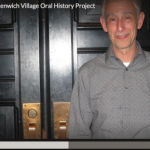
In a recent interview by The Library As Incubator Project, Ben Vershbow and David Riordan of NYPL Labs discussed an oral history pilot program launched by the lab in conjunction with the New York Public Library’s local branches.
The pilot program tackles the challenges of ingesting born-digital materials as well as connecting oral histories to other collections held by the Library. As Riordan says:
Many of the projects NYPL Labs works on deal with bringing historical materials into the digital world, but this project deals with “born digital†challenges.  Brian Foo has built a tool that’s not just about letting people listen to these histories, but also helps the library catalog, collect annotations, and connect them to other collections. It’s wild being able to listen to these stories, but then to be able to pull in photos and maps of the places they’re describing, plus see portraits of the storytellers. All in all, it makes the whole collection easier to search.
“Your Village, Your Story†is one such project. This community-based oral history project documents the history of Greenwich Village through the stories of those who experienced it. From December 2013 – April 2014, trained volunteer interviewers worked to collect over 100 oral histories of people who had a longtime relationship with Greenwich Village. The collection represents the voices of individuals who have lived, worked or spent over 20 years in the neighborhood.
The landing page for the project features Polaroid-like snapshots of the interviewees inviting the visitor to click and listen to the testimonies.  Clicking on a photo takes you to an individual interviewee page, where visitors can listen to each interview. The interface also allows the listener to annotate the interview by clicking a button or pressing enter when s/he hears an important person, place, event or thing mentioned. The program places a marker at that spot in the interview, and encourages you to transcribe that section. If you do, the marker becomes a text marker placed at the spot with the key term. The interface is well-designed, fun, and most importantly, engaging. You become an active listener of the interview, paying attention for keywords and phrases — and you help the institution catalogue the interview for future researchers. The annotated keywords also create ways to link the oral histories to books, photos, manuscripts and maps in the NYPL holdings.
Visit the project webpage and try it for yourself. One place to start is the interview with Angelo Verga, a poet, educator, and programmer at the Village’s famed Cornelia Street Cafe. Angelo was originally from the South Bronx, in a neighborhood that eventually became known as Fort Apache, in the 42nd Precinct. The community was a working class neighborhood in Angelo’s childhood but increasingly became rougher through the decades. Eventually he moved to Manhattan, and through a few lucky breaks and well-played cards, made his reputation in the Greenwich Village scene. Because I was listening intently for keywords and annotating his interview as he spoke, I remembered those details even a few days later.
-Jason Steinhauer, OHMAR BoardÂ
